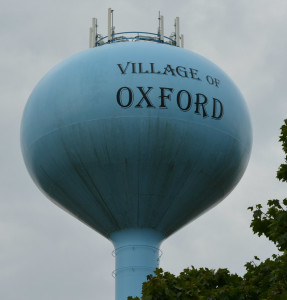Rather than raise water rates for the second time in two years, the Oxford Village Council last week voted 5-0 to form three ad-hoc committees tasked with finding new revenue streams for the municipality’s water fund, which is losing money.
One committee will explore the possibility of bottling and selling village water.
A second committee will look into finding wireless service providers interested in leasing antenna space on top of the village water tower.
The third committee is charged with increasing economic development in the village.
Additional revenue is needed because the water fund lost $230,000 in the 2015-16 fiscal year and is projected to lose another $151,000 in the current fiscal year, according to village Manager Joe Young.

The reason for the financial losses is the consumption of village water has decreased over the last few years.
Young said the village sold 134 million gallons in 2012 and 2013, but that number dropped to 103 million in 2014 and 105 million in 2015.
Less water consumed translates into less revenue for the village water fund, but it does not automatically lead to a decrease in operating expenses.
The water system expenses for the 2015-16 fiscal year amounted to $1.02 million, while the revenues equalled $790,000, according to the manager.
Young projects the water system expenses for 2016-17 will be $959,000, but the revenue will only be $808,000.
In response to this, Young had proposed raising water rates from $3.96 to $5.39 for every 1,000 gallons consumed.
The last time the village raised water rates was in October 2014.
But instead of once again increasing the financial burden on water customers, council decided to explore new ways to potentially generate revenue.
With regard to the possibility of bottling and selling Oxford water, village attorney Bob Davis explained “there have been some communities in Michigan” that have taken their “excess capacity” and “turned it into revenue for the local government.”
“No plans are set or anything, but somebody’s going to explore that,” he said.
Young said the village water system is capable of producing 2 million gallons per day and village water customers are not even using half of that.
According to the monthly water report for July regarding Oxford’s treatment plant, the average daily demand was 559,916 gallons. The peak day was 808,096 gallons, while the low day was 431,264 gallons.
Expanding the number of cell antennas on top of the village water tower on S. Glaspie St. is another potential revenue source.
There’s already one antenna up there serving AT&T customers, but, according to Davis, there’s room for four or five more, each of which could generate lease revenue for the village water fund.
“We are now actively pursuing tenants,” the attorney said.
Just one lease could generate $1,300 to $1,800 per month for the village, according to Davis.
He noted he’s been “approached” by a broker – or “matchmaker,” as he put it – that connects wireless carriers with potential antenna sites and they’re “very interested” in seeing what the village’s water tower has to offer.
“That’s under analysis at this point,” he said.
The village is not currently earning any revenue from AT&T’s presence on the tower because in 2012, council sold the remainder of its lease agreement with the wireless carrier – which was 14 years at the time – to the California-based Black Dot Capital & Real Estate Group for the lump sum of $345,000.
This money went into the water fund.
In exchange for that sum, the village also gave Black Dot control of that space on the tower for 50 years.
As for the committee charged with increasing economic development in the village, the bottom-line is new businesses become new water customers, which translates into more revenue for the fund.

Leave a Reply